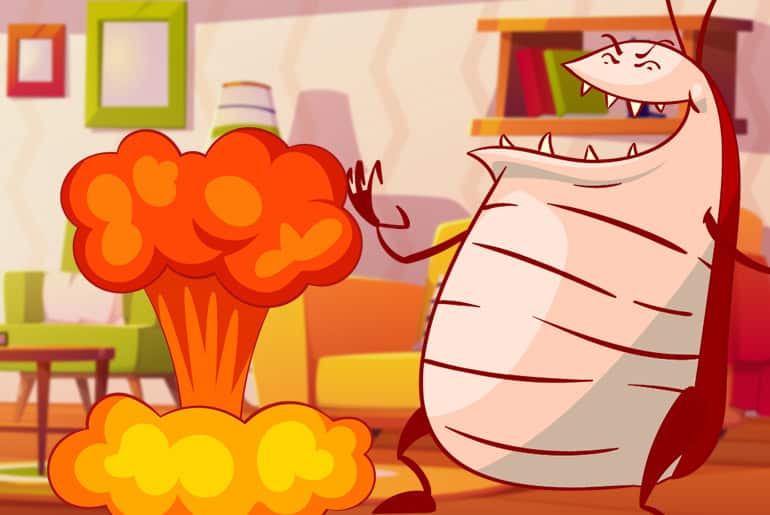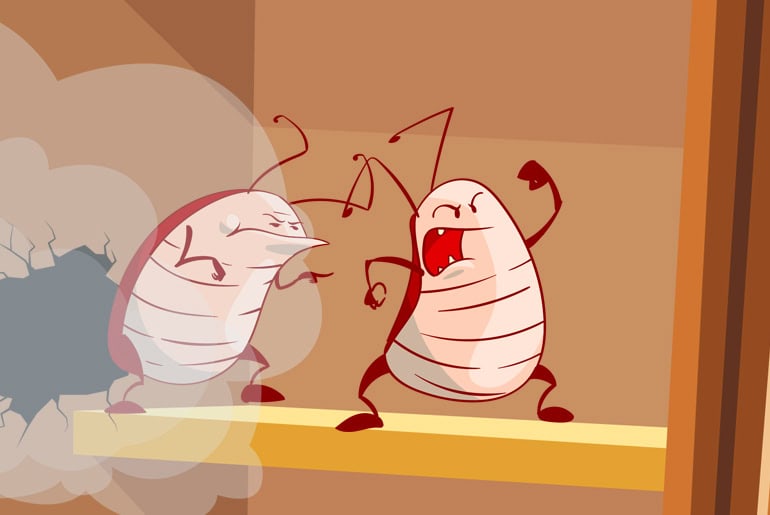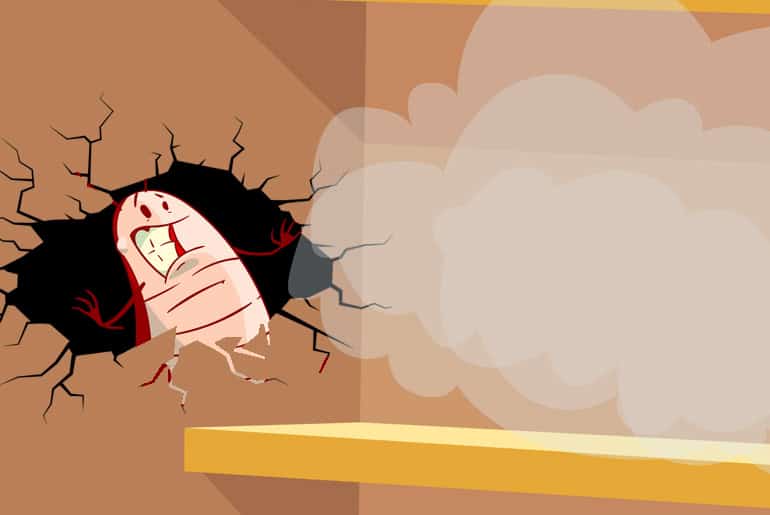Looking for the best roach bomb to eliminate an infestation in your home? You’ll find dozens of these products in stores advertising themselves as cheap, quick, “no-mess” solutions to your cockroach problems.
What if we told you that roach bombs and foggers aren’t effective against cockroaches?
There’s a better, cleaner and safer way to get rid of roaches. It’s not a product; it’s a game plan.
Ready for a powerful and effective roach removal system that you can start today? Let’s go.
A Simple 5-Step Guide For Getting Rid of Roaches
“Print or Follow on Your Phone. It’s FREE!”
Roach Bombs Just Don’t Work Very Well

They have many names—roach foggers, bug bombs, insect foggers—and make many claims, from killing cockroaches fast to reaching deep into crevices and even neutralizing odors. They rarely meet expectations.
Some call themselves “no-mess” products that work just about anywhere—houses, garages, attics, basements. When you activate a roach bomb, it sprays pesticides up toward the ceiling, letting the poisonous chemical mist settle onto all surfaces in its range. Imagine that—a canister that literally sprays pesticides across a room being a “no-mess” product! Not likely.
Despite clever and determined marketing, research has found little evidence to back up these products’ claims.
3 primary downsides make them less than effective:
1. Bug bombs for roaches rarely reach into cracks, crevices and other hiding places.

Are roach bombs effective? Not really. Basically, they throw a bunch of toxic chemicals into the air and hope to reach the tiny holes, crevices, and enclosed spaces where roaches hide. Usually, it doesn’t work.
A 2019 study found that store-bought roach bombs were completely ineffective at reducing German cockroach populations. Indoor bug bombs fail because they’re not sufficiently deep-reaching, and don’t hit the problem at its source: the roach’s nest. Even if foggers manage to kill a few cockroaches caught in the spray, they won’t have a long term effect.
2. Pyrethrin, a common cockroach bomb ingredient, doesn’t kill many cockroaches.

Pyrethrin (the active ingredient in many bug bombs) works against mosquitoes, flies and some other flying insects but it’s not consistently toxic to roaches or similar household pests. While it might flush roaches out of their hiding places, it’s fair to assume the last thing you want after using a cockroach bomb is to come home to see dozens of roaches emerging from walls and scurrying around the house.
3. Roaches might be frightened into hiding by a bug bomb.

If the roaches don’t frantically evacuate after you bomb a house for roaches, they might run for their lives in the opposite direction: deeper into crevices. Some products’ ingredients end up repelling roaches, making the infestation more difficult to eliminate.
Other Downsides to Using Roach Bombs

Cockroach foggers aren’t quick and easy solutions, despite what their marketing says. You, your family and all of your pets will have to leave your house for several hours, at least. You can’t stay in the house, even if you’re only bombing one room.
The dream would be spending an afternoon at the park or the mall as a fogger kills bugs in every corner of your home. The reality, though, is you’re going to return to hours of cleanup and not much difference otherwise.
You’ll have to cover all of your clothes and delicate furniture before activating the roach fogger. After it’s safe to return home, you’ll need to clean everything within range—up to 7,000 cubic feet! That means washing kitchen supplies, living room fabrics, furniture, pet toys and supplies, floors, walls and everything in between. You should wash sheets if you fogged near a bedroom, too.
A Roach killer bomb is not safe for people or pets. It’s vital that you wipe away all of the insecticide residue that might have settled in areas where your pets can reach. Pyrethrin can be especially toxic to fish and other water pets.
As if the cleanup weren’t bad enough, roach bombs can be explosive. In several instances, roach bombs caused explosions in homes when pilot lights ignited the gasses they emit. Even lit cigarettes and cigarette lighters have ignited roach fogger fumes.
Overall, roach bombs and insect foggers have proven to be ineffective and unnecessarily dangerous. Some indoor fogger products advertise use in cars but that’s not a great idea, either.
Luckily, there is a much better, safer and cleaner solution that will get rid of cockroaches for good.
Introducing… your step-by-step roach elimination game plan!
The Best Roach Bomb is a Strategic Game Plan

We’re not selling anything; we only want to clear up the confusion surrounding bug bombs and recommend a system that works and that you can start using today.
Here’s the breakdown:
- Trap and Bait
- Natural Insecticides
- Repel and Prevent
- Call for Backup (If needed)
Let’s dig into the details.
1. Use traps to find roaches and baits to kill them.
Your game plan starts with an inspection. It’s important to search floors, walls and cupboards for crevices where roaches can hide. Using a flashlight and a handheld mirror can help you see behind appliances and under furniture.
Sticky traps are a good first step because they’ll help you measure the size of the infestation and find where most of the roaches are hiding. Place them along walls where roaches are likely to travel. Other signs include roach droppings (which look like coffee grounds) and foul, musty odors, which roaches produce.
Once you’ve narrowed down your target areas, you can start using a gel bait product to eliminate the roach colony efficiently and, more importantly, at the source.
The same 2019 study that showed the disappointing roach bomb results also found that gel baits caused “significant declines in the cockroach populations.”
Gel bait (and bait stations) attract roaches, deliver a dose of a pesticide, then linger on the roach’s legs and in its digestive system until it dies back at its nest. There, as other roaches are exposed to it, they eat some of the poison, too.
Baits are vastly better than roach bombs because they eliminate cockroach problems at the source.
2. Add natural cockroach killers for a one-two pest control punch.
You can try staying away from chemicals entirely or use natural roach killers alongside a gel bait to boost your offense. Natural solutions include food-grade diatomaceous earth (DE) and boric acid, both of which are deadly to roaches.
Tip: While natural, boric acid and diatomaceous earth are not completely harmless. Both should only be used in isolated areas (like around pipes and behind refrigerators), kept away from children and pets, and applied according to label directions.
To use boric acid for example, you can mix it with equal parts of sugar or flour (to attract the roaches) and lightly sprinkle it in small areas roaches walk.
You should refresh the coating every day or several days, depending on the size of the infestation.
3. Build your defense with repellents and good cleaning habits.
Once you have the existing roaches under control, it’s vital that you stop any more from invading. That comes down to 2 things: repellents and prevention.
Repellents are the products and DIY solutions that will stop roaches in their tracks. There are chemical repellents (like residual sprays—the kinds you often see pest control companies using) and natural repellents. Both can be effective and, again, you can use a combination.
If you’re going the chemical route, you can use sprays or granular products to repel roaches (and kill the ones that try their luck). Natural repellents include certain essential oils, herbs and a few other surprising items.
Check out our guide to the best (and worst) natural roach repellents.
Prevention starts with closing off your home from these outside invaders. You should seal any holes, cracks or vents that roaches can crawl through, clear clutter from around your house and make sure you’re wiping down floors and countertops as often possible.
By eliminating food sources, standing water and entry points, you can make your home a fortress against pesky cockroach invaders.
Find even more tips in our overview of all the ways to keep cockroaches away.
4. If there are simply too many roaches, call in professional backup.
You can do a lot on your own but, sometimes, the infestation seems too large. Or, maybe you just don’t want to go through so much trouble to face it on your own.
You’ve still got an option: call your local pest control service. They’ll do the dirty work, safely applying pesticides and making sure every entry point is sealed and every hiding place is treated.
We’ve covered how to hire an exterminator from beginning to end.
Conclusion

You have a lot of options when dealing with cockroaches but there’s one you should avoid: the deceptively ineffective roach bomb. It might seem like a cheap and simple solution that kills roaches fast, but in the long run, it’s more likely to be a hassle that doesn’t actually eliminate your roach problem.
Instead, focus your energy on the game plan we’ve laid out for you—it’s proven to work and it’s based on how the professionals treat roach infestations. By following these steps, you can eliminate roaches and keep them out for good.
Go get ’em!
Sources
- Potter, Michael F. (2018) Limitations of Home Insect Foggers (“Bug Bombs”). University of Kentucky Entomology. Retrieved from https://entomology.ca.uky.edu/ef643
- Pesticide information: Active ingredient: Pyrethrin. University of California IPM. Retrieved from http://ipm.ucanr.edu/TOOLS/PNAI/pnaishow.php?id=62
- DeVries, Z.C., et al. (2019) Exposure risks and ineffectiveness of total release foggers (TRFs) used for cockroach control in residential settings. BMC Public Health. Retrieved from https://doi.org/10.1186/s12889–018–6371-z
- Ogg, Barb eat al. (2006) Cockroach Control Manual. University of Nebraska-Lincoln Extension.
4 Comments
Do you use the boric acid and de together?
Hi, since boric acid and DE attack roaches in similar ways (as dusts), most people use one or the other. If you wanted to use DE as a dust and boric acid in a bait, that would work well, too.
i am so satisfacted. greetings wally
i am so satisfacted.my english is poor, sorry :). thx for approving my user greetings wally